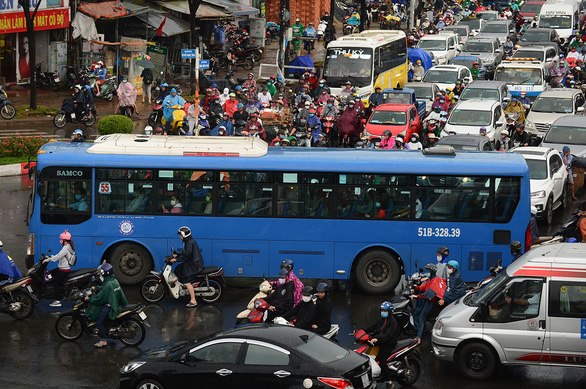The Ho Chi Minh City People’s Committee has unveiled its plan to incorporate 12- to 17-seater minibuses into its public transport system in a proposal submitted to Prime Minister Nguyen Xuan Phuc.
It is expected to help turn more motorbike drivers to public commuting, which would in turn alleviates the pressure on Ho Chi Minh City’s overloaded urban transport.
In the proposal, the People’s Committee stated that bus route coverage in urban Ho Chi Minh City only fared 1km/sqkm, which is much lower than the standard of 2.5 km/sqkm.
The city’s bus fleet consists of 2,322 vehicles on 137 routes, the majority of which are 41-60 seaters designed to operate on streets at least 10 meters wide.
However, among the city’s nearly 5,000 streets, 3,450 are less than seven meters wide, which makes it impossible for the majority of public buses to reach.
This is also considered the underpinning of the sub-par bus coverage in Ho Chi Minh, which put off many potential customers as they have to travel great lengths to use the bus system.
Considering the situation, the introduction of light buses is essential for Ho Chi Minh City’s smart city initiative, according to the proposal.
In its bid to solve the issue, the proposal envisions 20 new minibus routes to connect areas of the city with the forthcoming metro line No. 1, which runs from Ben Thanh Market in District 1 to Suoi Tien Theme Park in Thu Duc City, as well as 10 routes using light buses to plug passengers into BRT route No. 1 in the 2021-2022 phase.
As per current regulations, bus routes must employ vehicles with 17 seats or more, with areas for both sitting and standing passengers, with one exception that vehicles of 12-17 seats can operate on routes that cross narrow streets or bridges in more than half of their journeys.
Considering this, the Ho Chi Minh City People’s Committee is asking for permission from the prime minister to use light buses of 12 to 17 seats to boost coverage of the public bus system and help bring bus routes within reach of all city dwellers.
More choices
Le Trung Tinh, chairman of the Inter-Province and Tourism Passenger Transport Association, said that Ho Chi Minh City first proposed a light bus system in 2020, with six routes to cover new residential areas inaccessible by the city’s public commuting system.
As per the plan, the routes would have their fare set VND10,000-40,000 (US$0.43-1.73) per trip.
Vehicle cost would be covered by investors, while a partner will manage routes and customers via a dedicated ride-hailing application, where passengers could book tickets and track their bus in real-time.
However, the Ministry of Transport rejected the plan on the basis of Decree 10/2020, which requires that public buses have 17 seats or more.
This decree was also used to justify the rejection of Hanoi’s minibus proposal in 2018.
Vu Anh Tuan, director of the Vietnam-Germany Transportation Research Center, also deemed the introduction of minibuses requisite to Ho Chi Minh City as its road network consists of mostly small lanes that impede the entry of bigger vehicles and thwart the development of the public transportation system.
Meanwhile, minibuses will be able to navigate these streets and bring new customers who seek an intermediary means of transport to reach BRT and metro routes.
According to Tuan, Ho Chi Minh City is currently home to over 10 million citizens, which translates to roughly 30 million trips within the city per day given the average of three travels per person on any day.
In reality, the city’s bus system can only handle one million trips per day, or three percent of the approximated demand, while that number is expected to be 15 percent by 2025 and 30 percent by 2030, according to objectives set by city officials.
In order to reach these goals, the bus fleet in the city must be tripled, even quadrupled, Tuan remarked.
“Operational effectiveness will not be raised if only big buses are added to the fleet and put on routes with low demand,” he said.
“Minibuses, once introduced, will provide customers with more traveling choices.”
Like us on Facebook or follow us on Twitter to get the latest news about Vietnam!






















































